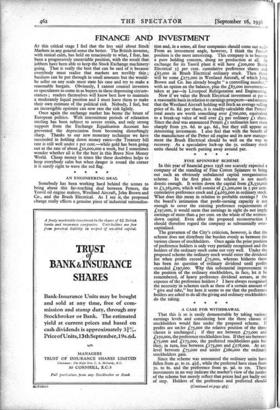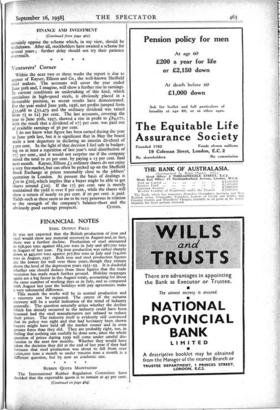FINANCE AND INVESTMENT
AT this critical stage I feel that the less said about Swck, Markets in any general sense the better. The British investor, with stoical calm, has held on tenaciously to what, I fear, has. been a progressively unenviable position, with the result that jobbers have been able to keep the Stock Exchange machinery , going. That is really the best that can be said of it because everybody must realise that markets are terribly thin ; business can be put through in small amounts but the would-. be seller on any scale must state his case and try to make a reasonable bargain. Obviously, I cannot counsel investors or speculators to come in as buyers in these depressing circum- stances; readers themselves will know best how to maintain a moderately liquid position and I must leave them to make their own estimate of the political risk. Nobody, I feel, but an incorrigible optimist can now rate the risk lightly.
Once again the exchange market has borne the brunt of European politics. With intermittent periods of relaxation sterling has been subject to severe strain, and only strong support from the Exchange Equalisation Account has prevented the depreciation from becoming disturbingly sharp. Thanks to our new monetary technique we have succeeded in holding down money rates—the Treasury bill rate is still well under x per cent.—while gold has been going out at the rate of about Lro,000,000 a week, but I sometimes wonder whether all is for the best in this Brave New Money World. Cheap money in times like these doubtless helps to keep everybody calm but when danger is round the corner it is surely right to wave the red flag.
* * * *
AN ENGINEERING DEAL
Somebody has been working hard behind the scenes to bring about this far-reaching deal between Petters, the Yeovil oil engine makers, Westland Aircraft, John Brown and Co., and the Brush Electrical. As I see it, the proposed change really effects a genuine piece of industrial rationalisa- lion and, in a sense, all four companies should come out well. From an investment angle, however, I think the Petters position is the most interesting. This company is to become a pure holding concern, doing no production at all. In exchange for its Yeovil plant it will have £200,000 Brush Electrical 5i- per cent. cumulative preference shares and £65,000 in Brush Electrical ordinary stock. Then there will be some £275,000 in Westland Aircraft, of which John Brown and Co. has already bought "a controlling number," with an option on the balance, plus the L85,000 investment— taken at par—in Liverpool Refrigeration and Engineering. Now if we value the Brush Electrical investment at par — a reasonable basis in relation to earnings prospects—and assume that the Westland Aircraft holding will fetch an average selling price of 6s. 8d. per share, it is readily calculable that Petters' total assets are worth something over £700,000, equivalent to a break-up value of well over £3 per ordinary Li share. Since the deal was announced Petters Li ordinaries have risen sharply from 37s. 6d. to 40. 6d., but they still appear an interesting investment. I also feel that with the benefit of the manufacture of the Fetter oil engine and its new manage- ment the Brush Electrical should be well on the way to recovery. As a speculative lock-up the 5s. ordinary stock units should be worth putting away around par.
* * * *
FINE SPINNERS' SCHEME
In this year of financial grace 1938 one scarcely expected a company of the standing of Fine Cotton Spinners to bring out such an obviously unbalanced capital reorganisation scheme. In the first place the scheme is not nearly drastic enough. It writes down the capital from £8,350,000 to £5,563,000, which will consist of £1,500,000 in 5 per cent. cumulative preference stock and £4,063,000 in ordinary stock. What does this mean in relation to probable earnings ? On the board's intimation that profit-earning capacity is not enough to cover the existing preference requirements of £197,000, it would seem that earnings in sight do not imply earnings of more than 4 per cent. on the whole of the written- down capital. Even after the proposed reconstruction I should therefore regard the company as substantially over- capitalised.
The gravamen of the City's criticism, however, is that the scheme does not distribute the burden evenly as between the various classes of stockholders. Once again the prior position of preference holders is only very partially recognised and the holders of the ordinary stock come out very well. Under the proposed scheme the ordinary stock would enter the dividend list when profits exceed £75,000, whereas hitherto there has been no question of ordinary dividend until profits exceeded £197,000. Why this substantial improvement in the position of the ordinary stockholders, in face, let it be remembered, of heavy preference dividend arrears, at the expense of the preference holders ? I have always recognised the necessity in schemes such as these of a certain amount of "give and take," but here it seems to me that the preference holders are asked to do all the giving and ordinary stockholders do the taking.
* * * * A CASE FOR WITHDRAWAL
That this is so is easily demonstrable by taking various earnings levels and considering how the three classes of stockholders would fare under the proposed scheme. If profits are unier £75,000 the relative position of the three classes is unchanged ; if they are between £75,000 and £250,000, the preference stockholders lose. If they are between £75,000 and £173,000, the preferred stockholders gain but they, in turn, lose between £173,000 and L278,000. At any level between £75,006 and under L260,000 the ordinary stockholders gain.
Since the scheme was announced the ordinary units have fallen from 4s. to 2s. 40., while the preferred have risen from 5s. to 6s. and the preference from 9s. 9d. to los. These movements in no way indicate the market's view of the justice of the scheme but merely reflect that prices had got badly out of step. Holders of the preference and preferred should
(Continued on' page 463)
FINANCE AND INVESTMENT (Continued from page 462) certainly oppose the scheme which, in my view, should be withdrawn. After all, stockholders have awaited a scheme for several years ; further delay should not try their patience overmtith.
Venturers' Corner Within the next two or three weeks the report is due to appear of Kayser, Ellison and Co., the well-known Sheffield steel makers. The accounts will cover the year ended June 3oth and, I imagine, will show a further rise in earnings. In current conditions an undertaking of this kind, which specialises in high-speed steels, is obviously placed in a favourable position, as recent results have demonstrated. For the year ended June 3oth, 1936, net profits jumped from £35,968 to £51,473 and the ordinary dividend was raised from 71, to I2i per cent. The last accounts, covering the year to June 3oth, 1937, showed a rise in profit to £84,171, with the result that a dividend of 171 per cent. was paid out of available earnings of 36 per cent.
I do not know what figure has been earned during the year to June 3oth last, but it is significant that in May the board made a new departure in declaring an interim dividend of 5 per cent. In the light of that decision I feel safe in budget- ing on at least a repetition of last year's total distribution of 17! per cent., and it would not surprise me if the company raised the total to 20 per cent. by paying a 15 per cent. final next month. Kayser, Ellison Ls ordinary shares do not enjoy a very free market, but can often be picked up on the Sheffield Stock Exchange at prices reasonably close to the jobbers' quotation in London. At present the basis of dealings is £m to Liol,which implies that a buyer might be able to get shares around Dof. If the 171 per cent. rate is merely maintained the yield is over 8 per cent., while the shares will show a return of nearly to per cent. if 20 per cent, is paid. Yields such as these seem to me to be very generous in relation to the strength of the company's balance-sheet and the











































 Previous page
Previous page